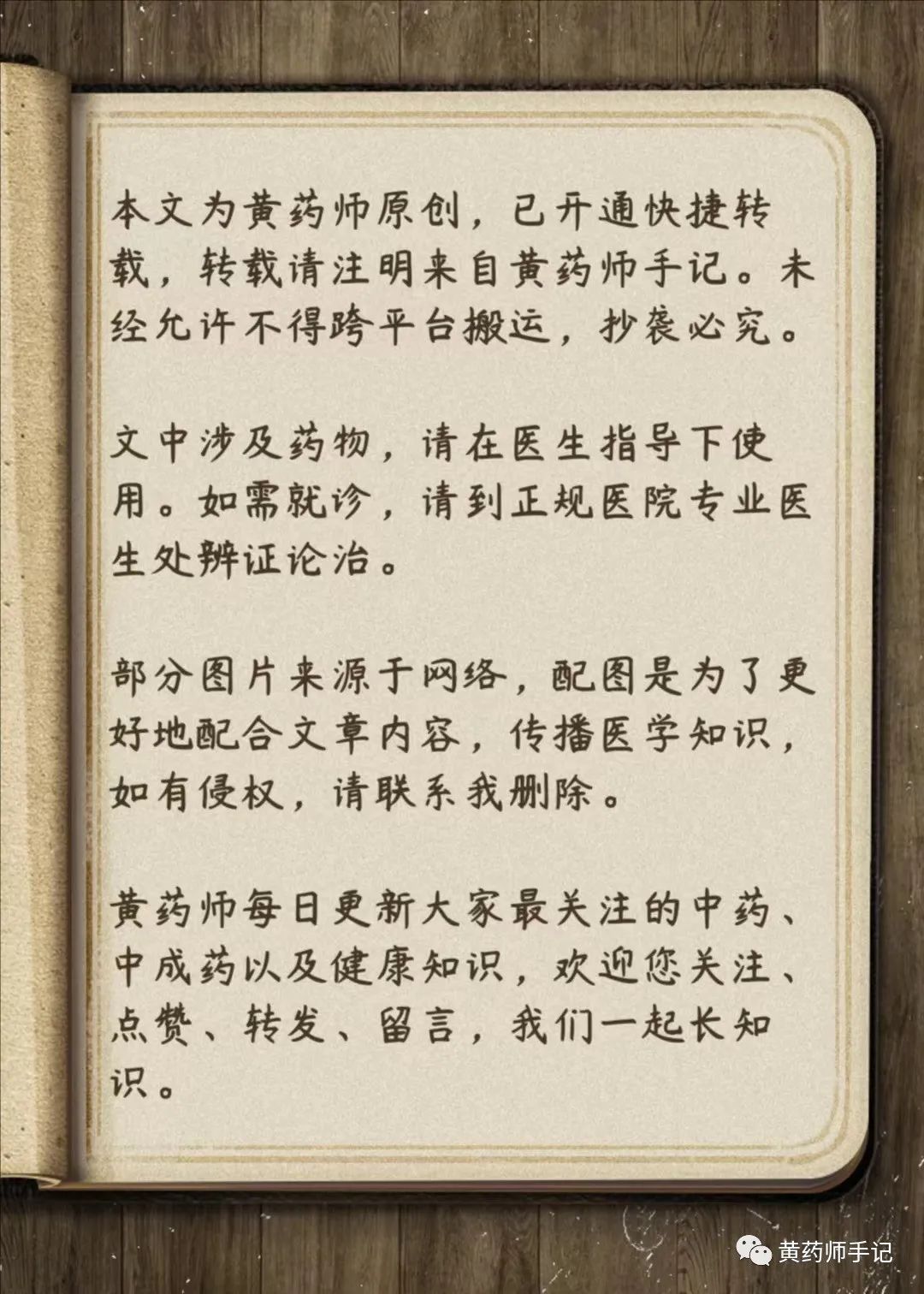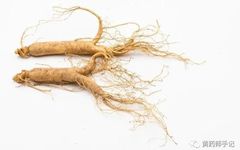Ginseng is one of the most commonly discussed traditional Chinese medicines, often depicted in ancient Chinese stories as a miraculous herb, capable of reviving the dead, sustaining life, and fetching a high price of a thousand taels for a thousand-year-old ginseng… So, is real ginseng really that magical?
Today, Huang Yaoshi will discuss ginseng.
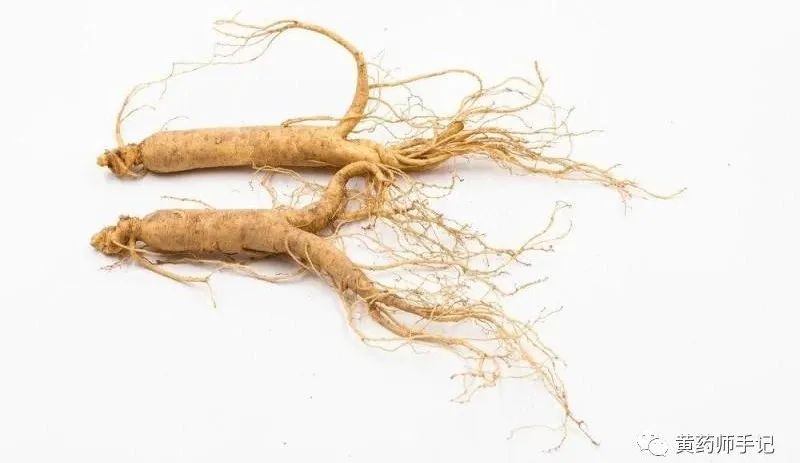
Ginseng
1. What are the benefits of ginseng?
1. Symptoms of extreme Qi deficiency due to internal injury, excessive sweating, vomiting, diarrhea, or significant blood loss
Ginseng can save lives in dangerous situations, including:
(1) Qi deficiency leading to collapse: Du Shen Tang (Ginseng Decoction), which uses ginseng alone, can be used for weak pulse, heart failure, and traumatic shock.
(2) Qi deficiency with Yang collapse: Shen Fu Tang (Ginseng and Aconite Decoction), which combines ginseng with Aconitum, is used for Yang deficiency with cold extremities; modern formulations include ginseng and aconite injections for emergencies.
(3) Qi deficiency with Yin collapse: Sheng Mai San (Generate Pulse Powder), which combines ginseng with Mai Dong (Ophiopogon) and Wu Wei Zi (Schisandra), is used for simultaneous Qi and Yin deficiency, excessive sweating, and thirst. The three-herb formula Sheng Mai Yin (Ginseng Decoction) is used for palpitations and shortness of breath. Modern formulations include ginseng and Mai Dong injections for cardiogenic shock.
(4) Blood deficiency with Qi collapse: Liang Yi Gao (Two Principles Paste), which combines ginseng with Shu Di Huang (Rehmannia), is used for exhaustion from overwork and post-illness weakness; it can also be combined with Dang Gui (Angelica), Shu Di, and Gou Qi Zi (Goji) for postpartum Qi and blood replenishment.
2. Spleen deficiency
(1) Spleen Qi deficiency: can be used for symptoms like reduced appetite, abdominal distension, loose stools, and fatigue due to spleen Qi deficiency, often combined with Bai Zhu (Atractylodes), Fu Ling (Poria), and Gan Cao (Licorice), such as in Si Jun Zi Tang (Four Gentlemen Decoction).
(2) Middle Qi sinking: Middle Qi refers to the Qi of the spleen and stomach; sinking of Middle Qi often leads to chronic diarrhea, prolapse of the rectum, gastric ptosis, heaviness of the eyelids, and a feeling of heaviness in the lower abdomen. It is often combined with Huang Qi (Astragalus), Bai Zhu, and Sheng Ma (Cimicifuga), such as in Bu Zhong Yi Qi Tang (Tonify the Middle and Augment the Qi Decoction).
(3) Spleen not governing blood: One of the functions of the spleen is to govern blood, but when it fails to do so, it can lead to abnormal bleeding, such as blood in the stool, urine, nosebleeds, and menorrhagia. It is often combined with Huang Qi, Bai Zhu, and Dang Gui, such as in Gui Pi Tang (Restore the Spleen Decoction).
(4) Spleen Yang deficiency: Symptoms may include abdominal pain, cold extremities, and edema; it can be combined with Bai Zhu, Gan Jiang (Dried Ginger), and Zhi Gan Cao (Honey-fried Licorice), such as in Li Zhong Wan (Regulate the Middle Pill).
(5) Spleen Yin deficiency: The spleen fails to nourish and transport, often leading to symptoms like poor appetite, gastric burning pain, abdominal distension after eating, dry heaving, constipation, and dry mouth. It is often combined with Shan Yao (Chinese Yam) and Lian Zi (Lotus Seed) to tonify the spleen and nourish Yin.
3. Lung deficiency
(1) Lung Qi deficiency: Symptoms include cough, shortness of breath, inability to lie flat, spontaneous sweating, and low voice; it can be combined with Wu Wei Zi, Zi Su Zi (Perilla Seed), and Sang Bai Pi (Mulberry Bark).
(2) Lung Qi and Yin deficiency: Symptoms include cough with choking, little phlegm, wheezing, and dry mouth; it can be combined with Wu Wei Zi and Mai Dong.
(3) Lung and Kidney deficiency: Symptoms include chest tightness, wheezing, inability to lie flat, excessive breathing, spontaneous sweating, fatigue, and weakness in the lower back and knees, which can be combined with He Tao Ren (Walnut) and Ge Jie (Gecko).
4. Heart Qi deficiency
Used for palpitations, anxiety, and insomnia due to insufficient heart Qi, often combined with Yuan Zhi (Polygala), Fu Ling, Shi Chang Pu (Acorus), and Suan Zao Ren (Sour Jujube Seed).
It can also be used for improving memory and alleviating brain fatigue in adolescents and the elderly, often combined with Yuan Zhi and Shi Chang Pu, such as in Kong Sheng Zhen Zhong Dan (Confucius Pillow Elixir).
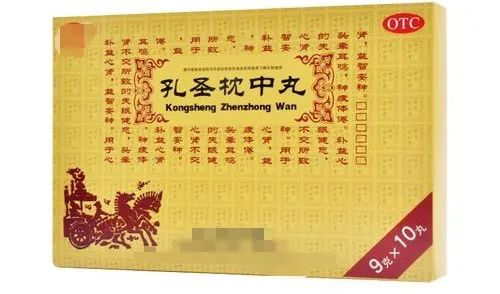
Images are for reference only; please use proprietary Chinese medicines under the guidance of a physician.
5. Diabetes and excessive thirst
Ginseng can generate fluids and alleviate thirst, useful for heat syndromes with thirst, such as in Shang Han Lun Bai Hu Jia Ren Shen Tang (White Tiger Decoction with Ginseng).
It can also be used for diabetes; clinically, ginseng has been used in combination with Shi Gao (Gypsum), Zhi Mu (Anemarrhena), Sheng Di (Rehmannia), and Shan Yao to improve the dawn phenomenon of diabetes (characterized by high blood sugar at 3 AM and before breakfast).
6. Kidney deficiency and impotence
It can be used for functional impotence in the elderly, either alone or combined with Yin Yang Huo (Epimedium) and Rou Cong Rong (Cistanche).
7. Exhaustion and premature aging
Ginseng can nourish both innate and acquired Qi, strengthen the body, and prolong life. It is useful for those with weak constitutions and premature aging.
It can also be used for children with insufficient constitution, developmental delays, or those who are thin and have poor appetite, often combined with kidney-tonifying or spleen-replenishing herbs.
8. External pathogenic diseases during the Qi deficiency phase
It can be used for Qi deficiency with external wind-cold, often combined with Qian Hu (Peucedanum) and Jie Geng (Platycodon), such as in Ren Shen Bai Du San (Ginseng Decoction to Overcome Pathogenic Factors).
2. When should ginseng not be used?
1. Avoid with Wu Ling Zhi and Lai Fu Zi?
Not necessarily. Traditionally, it is believed that ginseng is incompatible with Li Lu, Wu Ling Zhi, and Lai Fu Zi (Radish Seed). However, there are exceptions.
Ginseng can be used with Wu Ling Zhi: For example, in Wen Bing Tiao Bian, Huazheng Huisheng Dan is used to treat abdominal masses, dysmenorrhea, amenorrhea, and traumatic injuries, combining ginseng with Wu Ling Zhi.
Ginseng can be used with Lai Fu Zi: Zhang Xichun in Yixue Zhongzheng Canxi Lu emphasizes that ginseng and Lai Fu Zi can be used together; Lai Fu Zi can alleviate the bloating caused by ginseng without diminishing its Qi-replenishing effects.
2. Not suitable for excess conditions or heat syndromes
Excess conditions are generally caused by external pathogens or the early stages of disease, where pathological products accumulate, leading to unwanted symptoms. They are more common in young and robust individuals. Symptoms may include signs of Yang, heat, stagnation, and obstruction, typically with a pale tongue, thick greasy coating, and a strong pulse.
3. Do not take in excess
If one is not deficient to that extent, there is no need to take excessive amounts of ginseng, as it can lead to “over-replenishment”.
Excessive consumption of ginseng can lead to symptoms similar to those of Tong Xiangyu in Wu Lin Wai Zhuan, such as elevated blood pressure, nosebleeds, extreme excitement, irritability, insomnia, nervousness, and dizziness; in severe cases, it can even lead to death.
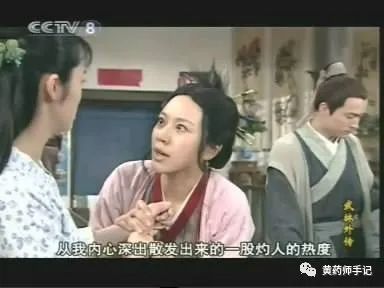 The reason only ginseng has this “abuse syndrome” is that people have historically believed ginseng to be a great tonic, leading to the notion that “ginseng cannot harm anyone”. Thus, even those who are not deficient take it, and excessive use can lead to abuse.
The reason only ginseng has this “abuse syndrome” is that people have historically believed ginseng to be a great tonic, leading to the notion that “ginseng cannot harm anyone”. Thus, even those who are not deficient take it, and excessive use can lead to abuse.
5. Can cause precocious puberty in adolescents
Ginseng has the effect of promoting the maturation of the gonads; if used excessively in adolescents, it can lead to precocious puberty. Therefore, caution is advised when using ginseng in children and adolescents.
3. Huang Yaoshi’s Tips: What are the types of ginseng?
(1) By cultivation method
1. Wild mountain ginseng: Wild, grown in the mountains, currently a protected endangered species, and relatively expensive.
2. Garden ginseng: Cultivated, relatively inexpensive.
3. Forest-grown mountain ginseng/seed sea: Ginseng sown in a wild state in the mountains.
4. Transplanted mountain ginseng: Young wild mountain ginseng is dug up and transplanted to fields, or young garden ginseng is transplanted to the wild, resulting in ginseng that has undergone a “transformation”.
(2) By processing method
1. Raw sun-dried ginseng: Garden ginseng that is cleaned and sun-dried. It has not been steamed, thus retaining a higher content of active ingredients. However, it is not durable for storage. According to TCM theory, raw sun-dried ginseng has not undergone fire treatment, making its properties neutral and slightly cold, hence some ancient texts describe ginseng as slightly cold.
2. Red ginseng: Garden ginseng that has been steamed and then dried or baked. Its advantages and disadvantages are the opposite of raw sun-dried ginseng; the disadvantage is that the active ingredients are somewhat diminished due to steaming. However, after high-temperature treatment, the active ingredients are less likely to hydrolyze, making it more durable for storage, sometimes lasting 3-5 years. Since red ginseng has undergone fire treatment, ancient texts record it as having warming properties.
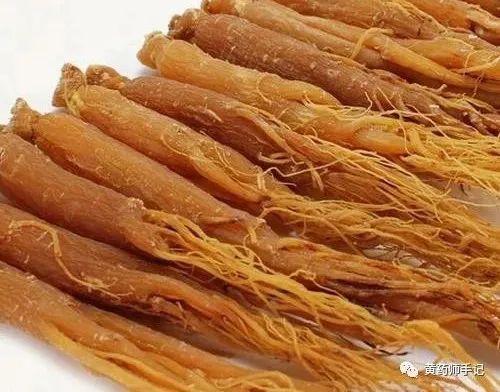
Red ginseng
3. Sugar ginseng/white sugar ginseng/white ginseng: Garden ginseng that has been blanched in boiling water and then soaked in sugar juice, then dried. White sugar ginseng is generally made from ginseng that has not grown well or has been damaged, and since sugar constitutes part of its weight, the overall quality is not high.
4. Raw sun-dried mountain ginseng: Dried wild mountain ginseng.
5. Edge ginseng: Similar to red ginseng, characterized by longer roots, cylindrical shape, and longer lateral roots, with the fibrous roots removed.
(3) By origin
1. Shangdang ginseng: Shangdang ginseng is not the same as Dang Shen; it refers to ginseng that was primarily produced in the Wutai Mountain area of Shanxi in ancient times. However, due to overharvesting and deforestation in the Ming Dynasty, there is little ginseng left from this area today.
2. Northeast ginseng/Jilin ginseng/Changbai ginseng: Ginseng produced in the Northeast region.
3. Korean ginseng/Chosun ginseng/Silla ginseng/Baekje ginseng/Goryeo ginseng: Ginseng produced in the Korean Peninsula.
4. Eastern ginseng: Ginseng produced in Japan.
According to the records of Tao Hongjing in Ben Cao Jing Ji Zhu and Li Shizhen in Ben Cao Gang Mu, Shangdang ginseng is of the highest quality, but it is now extinct; followed by Northeast ginseng, then Korean ginseng, with Eastern ginseng being of the lowest quality.
